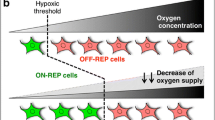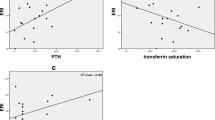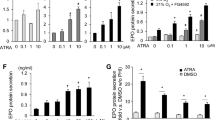Abstract
Introduction
Anemia is an inevitable outcome of chronic renal failure due to the kidney’s decreased ability to produce erythropoietin (EPO). We examined the feasibility of isolating and expanding EPO-producing cells for cell-based therapy.
Materials and methods
Renal cells from 7- to 10-day-old mice were culture-expanded. The cells at each subculture stage were characterized for EPO expression, using immunocytochemistry, FACS, and Western Blot analysis, with EPO-specific antibodies. To assess the levels of EPO expression, cells incubated under normoxic and hypoxic conditions were analyzed.
Results
Immunocytochemical analysis of the cultured renal cells expressed EPO at each subculture stage (P1–P3). Western Blot analysis of the detergent-solubilized cell extracts detected EPO (34 kDa) protein in the kidney cells of all passages tested.
Conclusion
These results demonstrate that EPO-producing renal cells can be grown and expanded in culture. The cells stably expressed EPO at multiple subculture stages and they are able to form tissue in vivo. This study shows that EPO-producing cells may be used as a potential treatment option for anemia caused by chronic renal failure.



Similar content being viewed by others
References
Eschbach JW (1989) The anemia of chronic renal failure: pathophysiology and the effects of recombinant erythropoietin. Kidney Int 35:134
Yamaguchi-Yamada M, Manabe N, Kiso M et al (2005) Dysfunction of erythropoietin-producing interstitial cells in the kidneys of ICR-derived glomerulonephritis (ICGN) mice. J Vet Med Sci 67:891
Horiguchi H, Kayama F, Oguma E et al (2000) Cadmium and platinum suppression of erythropoietin production in cell culture: clinical implications. Blood 96:3743
Bondurant MC, Koury MJ (1986) Anemia induces accumulation of erythropoietin mRNA in the kidney and liver. Mol Cell Biol 6:2731
Sasaki R, Masuda S, Nagao M (2000) Erythropoietin: multiple physiological functions and regulation of biosynthesis. Biosci Biotechnol Biochem 64:1775
Katavetin P, Inagi R, Miyata T et al (2007) Erythropoietin induces heme oxygenase-1 expression and attenuates oxidative stress. Biochem Biophys Res Commun 359:928
Katavetin P, Tungsanga K, Eiam-Ong S, Nangaku M (2007) Antioxidative effects of erythropoietin. Kidney Int Suppl (107):S10–S15
Vesey DA, Cheung C, Pat B et al (2004) Erythropoietin protects against ischaemic acute renal injury. Nephrol Dial Transplant 19:348
Bamgbola OF, Kaskel F (2005) Role of folate deficiency on erythropoietin resistance in pediatric and adolescent patients on chronic dialysis. Pediatr Nephrol 20:1622
Tsouchnikas I, Tsilipakou M, Daniilidis M et al (2007) Effect of iron loading on peripheral blood lymphocyte subsets and on circulating cytokine levels in iron-depleted hemodialysis patients receiving erythropoietin. Nephron 107:c97
Dutka P (2007) Hidden hemolysis. Nephrol Nurs J 34:223
Harman E, Dutka P (2007) Hemolysis: a hidden danger. Nephrol Nurs J 34:219
Goodnough LT (2001) Erythropoietin therapy versus red cell transfusion. Curr Opin Hematol 8:405
von Hartitzsch B, Kerr DN, Morley G et al (1977) Androgens in the anaemia of chronic renal failure. Nephron 18:13
Navarro JF, Mora C (2001) Androgen therapy for anemia in elderly uremic patients. Int Urol Nephrol 32:549
Navarro JF, Mora C (2001) In-depth review effect of androgens on anemia and malnutrition in renal failure: implications for patients on peritoneal dialysis. Perit Dial Int 21:14
Alexander MR (2001) Use of androgens in chronic renal failure patients on maintenance hemodialysis. Am J Hosp Pharm 33:242
Lin F-K, Suggs S, Lin C-H et al (1985) Cloning and expression of the human erythropoietin gene. Proc Natl Acad Sci USA 82:7580
Eschbach JW, Egrie JC, Downing MR et al (1987) Correction of the anemia of end-stage renal disease with recombinant human erythropoietin. Results of a combined phase I and II clinical trial. N Engl J Med 316:73 [see comment]
Rinsch C, Dupraz P, Schneider BL et al (2002) Delivery of erythropoietin by encapsulated myoblasts in a genetic model of severe anemia. Kidney Int 62:1395
Bretzel RG, Jahr H, Eckhard M et al (2007) Islet cell transplantation today. Langenbecks Arch Surg 392:239
Brittberg M, Peterson L, Sjogren-Jansson E et al (2003) Articular cartilage engineering with autologous chondrocyte transplantation. A review of recent developments. J Bone Joint Surg Am 85-A(Suppl 3):109
Erslev AJ, Wilson J, Caro J (1987) Erythropoietin titers in anemic, nonuremic patients. J Lab Clin Med 109:429
Sabahi R, Anolik JH (2006) B-cell-targeted therapy for systemic lupus erythematosus. Drugs 66:1933
Lanza RP, Chung HY, Yoo JJ et al (2002) Generation of histocompatible tissues using nuclear transplantation. Nat Biotechnol 20:689
Amiel GE, Atala A (1999) Current and future modalities for functional renal replacement. Urol Clin North Am 26:235
Atala A (1999) Engineering tissues and organs. Curr Opin Urol 9:517
Atala A (2004) Tissue engineering for the replacement of organ function in the genitourinary system. Am J Transplant 4(Suppl 6):58
Maxwell PH, Osmond MK, Pugh CW et al (1993) Identification of the renal erythropoietin-producing cells using transgenic mice. Kidney Int 44:1149
Remuzzi G, Minetti L (2000) Hematologic consequences of renal failure. In: Brenner BM (ed) Brenner and Rector’s The Kidney, vol 2. Saunders, Philadelphia, p 2079
Zaroulis CG, Hoffman BJ, Kourides IA (1981) Serum concentrations of erythropoietin measured by radioimmunoassay in hematologic disorders and chronic renal failure. Am J Hematol 11:85
Amiel GE, Yoo JJ, Atala A (2000) Renal therapy using tissue-engineered constructs and gene delivery. World J Urol 18:71
Atala A (2001) Tissue engineering in urology. Curr Urol Rep 2:83
Atala A (2003) Regenerative medicine and urology. BJU Int 92(Suppl 1):58
Atala A (2005) Tissue engineering, stem cells and cloning: current concepts and changing trends. Expert Opin Biol Ther 5:879
Atala A, Koh CJ (2004) Tissue engineering applications of therapeutic cloning. Annu Rev Biomed Eng 6:27
Hodges SJ, Atala A (2006) Initial clinical results of the bioartificial kidney containing human cells in ICU patients with acute renal failure. Curr Urol Rep 7:41
Krantz SB (1991) Erythropoietin. Blood 77:419
Dordal MS, Wang FF, Goldwasser E (1985) The role of carbohydrate in erythropoietin action. Endocrinology 116:2293
Ratcliffe PJ (1993) Molecular biology of erythropoietin. Kidney Int 44:887
Koury MJ, Bondurant MC (1990) Erythropoietin retards DNA breakdown and prevents programmed death in erythroid progenitor cells. Science 248:378
Acknowledgments
This work was supported by Tengion, Inc., through a Sponsored Research Agreement. The authors would like to thank Dr. Jennifer Olson for editorial assistance.
Conflict of interest statement
James Yoo and Anthony Atala serve as consultants for Tengion, Inc.
Author information
Authors and Affiliations
Corresponding author
Additional information
Tamer Aboushwareb and Fernanda Egydio contributed equally to this article.
Rights and permissions
About this article
Cite this article
Aboushwareb, T., Egydio, F., Straker, L. et al. Erythropoietin producing cells for potential cell therapy. World J Urol 26, 295–300 (2008). https://doi.org/10.1007/s00345-008-0301-0
Received:
Accepted:
Published:
Issue Date:
DOI: https://doi.org/10.1007/s00345-008-0301-0




